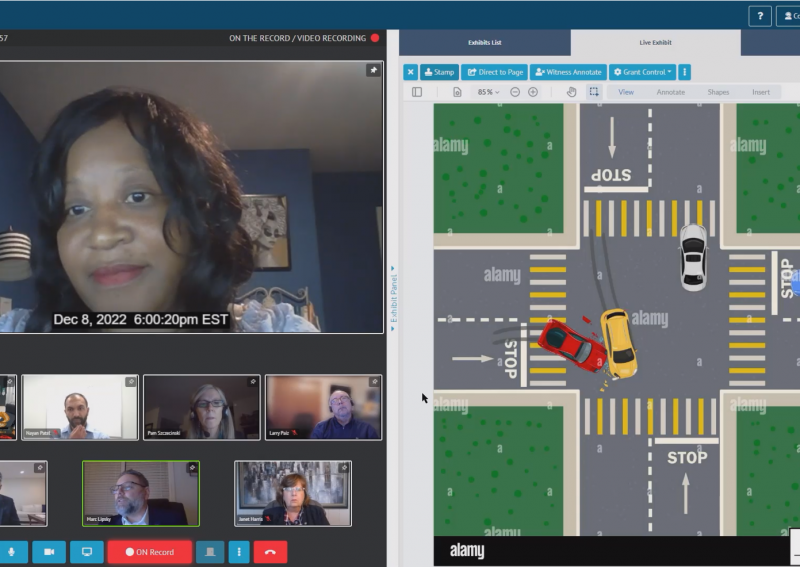
Remote depositions have made a giant splash in litigation in recent history. Years ago, to depose a witness remotely, it would require expensive video conferencing systems and the court reporter would still need to appear live with either the attorney or the witness. Video conferencing was prohibitive to many parties who were looking to contain costs. With the world becoming more accepting of a remote workforce over the past several years, the legal industry has had to make accommodations of its own to improve the litigation process.
Here are the top five reasons why remote depositions will continue to play a major factor in civil cases for the foreseeable future:
The Future of Depositions
- The Court Reporting Shortage
According to the National Court Reporters Association, there are roughly 1,120 stenographers leaving the field each year and roughly 200 new reporters replacing them. This staggering number has left the industry rushing to come up with alternative solutions. Oftentimes, scheduling a court reporter for a live proceeding can come with a hefty price tag. Scheduling departments are struggling to find live reporters to cover the daily jobs and may turn depositions down when they cannot find coverage. In order to entice reporters to take jobs in person, many firms will offer a per diem. Depending on the market, the per diems could vary from $100 all the way up to $1,000 just to get a certified stenographer to appear. With remote depositions, court reporters are now able to eliminate their commute and travel costs allowing them to take as many as 2 or 3 depositions a day. When reporters are expected to participate live at a deposition, they may only be able to cover one per day due to travel time. Remote and hybrid depositions allow for court reporters to take more jobs and alleviate the pain point of travel.
- Any Witness – Anywhere
According to The Federal Rules of Civil Procedure, Rule 45, live depositions would need to take place within 100 miles of where a witness resides, is employed, or regularly does business. Prior to remote depositions, this rule would be a headache for attorneys with clients in extremely remote areas. Oftentimes, there were limited appropriate locations to host a live deposition and if you were lucky enough to find one, you would then need to find a court reporter in that remote area or find one willing to travel. The price tag on these depositions would usually include hefty travel costs for the court reporters, videographers, attorneys, and anyone else who needed to appear live. With the adoption of remote depositions, it has been ruled that Rule 45(c) only applies if the deponent needs to travel. This means that remote depositions can be taken with deponents living anywhere in the country without the need to find a suitable location to host the event or a court reporter that is willing to travel. Furthermore, this opens an entirely new option for deponents who are living abroad. Once a costly event that required parties to travel internationally, these depositions can be taken at the same cost as a deponent living in the United States.
- Cost Savings
The amount of time and money saved with remote depositions is beyond compare. The most notable money-saver would be the cost of travel. Gone are the days of catching a flight to take a live deposition, which would often include the added cost of accommodations. Another cost saver that is less discussed is the money saved reproducing hundreds of exhibits, with multiple copies, prior to the deposition. With most exhibits being produced digitally in the remote world, each party is responsible for printing their own copy, if they even decide to do so. The average cost of a black and white copy is roughly 25 cents. For 500 pages of exhibits, for 3 parties, your exhibit costs alone would be roughly $375 for one deposition, not including additional costs for color copies and high-quality photos.
- Time Savings
With the ability to depose a witness, at any time, attorneys and court reporters no longer face long commutes to and from depositions. Depositions with witnesses on opposite coasts can now be scheduled back-to-back with only minutes of break in between. The amount of time saved with remote depositions is not only limited to travel. Exhibits are often delivered at a much quicker rate as they exist in a totally digital format and no longer need to be individually scanned by the court reporting firm. Another key piece to timesaving is the ability to quickly schedule depositions. A remote deposition can often be coordinated in less than an hour, whereas a live deposition would take hours to coordinate and then to get everyone at the location and prepared. Last-minute remote depositions have a much higher likelihood of proceeding versus the live alternative, enabling witnesses who are difficult to pin down to be deposed relatively easily.
- Accessibility
Remote depositions have opened the door to being more accessible to people who previously could not afford the cost of expensive litigation. This has enabled people who would once pass over on hiring an attorney to participate in the civil litigation process. This has also provided opportunities for attorneys to do work in arenas they previously would have avoided due to cost and time constraints. Remote depositions enable the entire industry to proceed with ease while still maintaining the security and integrity of the deposition process.
Nearly every state in the US has adopted a remote oath policy, allowing remote depositions to proceed. Even without those policies in place, attorneys are still able to stipulate a remote oath on the record with the agreement of all parties. As the workforce continues to shift to be more and more remote, it looks like remote depositions will be a very active and vital part of the litigation sector.

